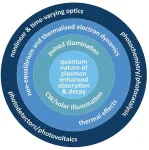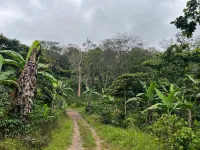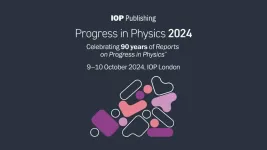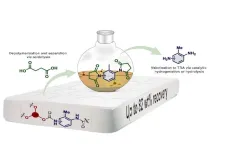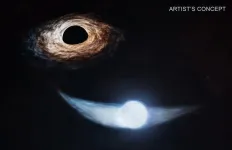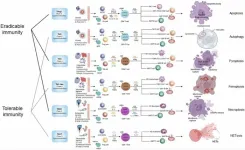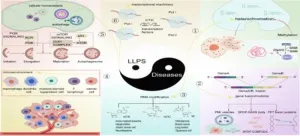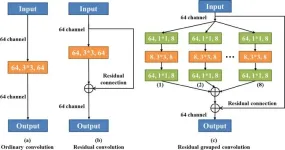(Press-News.org) Imagine having to do your job, but not being able to visually process the data right in front of you. Nearly eight percent of genetic males and half a percent of genetic females have some form of Color Vision Deficiency (CVD), or the decreased ability to discern between particular colors. CVD is commonly referred to as color blindness.
Scientists use colors to convey information. Many scientists in the weather radar community have CVD and the use and interpretation of color is an important aspect of their work. Most colormaps don’t take into account those with CVD; for instance, the maps show green next to red.
“Radar meteorology is a unique visual science. Scientists can see the shape in the storm that would signal strong winds or a tornado. That is why colormaps are so important to our community.” – Scott Collis, Argonne atmospheric scientist and co-author of the paper
Researchers from the U.S. Department of Energy’s (DOE) Argonne National Laboratory recently published a paper in the Bulletin of the American Meteorological Society detailing their work to create CVD-friendly colormaps that highlight important characteristics of clouds and precipitation.
Creation of new maps demonstrates programming community’s dedication to inclusivity
One type of colormap, Ze, shows radar reflectivity or storm intensity. The higher the reflectivity factor, the higher chance there is for rain, hail and more. In general, the higher the Ze, the higher the chance of public impact. These colormaps are ones most commonly seen by the general public in local weather forecasts.
Some colormaps, like Ze, are difficult for individuals with CVD to distinguish between varying types of precipitation and convection. Convection is the transport of heat and moisture by the movement of a fluid. Thunderstorms are one form of convection.
Another problem with the current colormaps is that they are not perceptually uniform. Perceptual uniformity is when changes in color (lightness or color) and data values are weighted equally and do not create artificial structure.
As the scientists interacted with the community, they realized they needed to do a better job displaying data. Their work focused on finding the right color representation that was both CVD-friendly and good for the radar community. The researchers took this knowledge and created CVD-friendly Ze and velocity colormaps using Python programming language tools. They gave everything its own color, from drizzle to rain to hail. Velocity colormaps were also tested using an existing oceanography map.
“The Python programming community aims to be inclusive,” said Scott Collis, an Argonne atmospheric scientist and co-author of the paper. “And there was this push from users to make colormaps more accessible.”
With testing and release complete, maps will make longer-term impact through next-generation meteorologists
The new and existing colormaps were tested on different weather events using software that visualized the data through the eyes of an individual with CVD. Comparisons were then provided to the CVD community for their input and feedback. Overall, radar researchers in the focus group agreed that the new colormaps were more interpretable than the default colormaps currently utilized.
This research was supported by the Atmospheric Radiation Measurement (ARM) User Facility, a DOE Office of Science User Facility.
“ARM is facilitating great science, visualizations and tools that are open to the community,” said Collis. “Without ARM, none of this would be possible and in practicing open science, ARM data, tools and software are more impactful.”
The new colormaps are now available in a GitHub repository that is used by a variety of open-source radar software packages found in the open radar community.
To further engage the CVD community, the authors presented their colormaps at important scientific conferences around the world. The community provided feedback, tested colormaps and helped build the library.
“Now that we have better colormaps, we know from the community that they are relevant and inclusive,” said co-author and Argonne Systems Integration Admin Zachary Sherman. “People have a choice to be colorblind friendly.”
Some of the authors have personally experienced how their colormaps have impacted those with CVD. Everyone from students to conference co-chairs have expressed their gratitude for colormaps they could finally understand. Providing these CVD-friendly colormaps allows for equitable scientific visualization and inclusivity.
Going forward, the research team plans to develop more colormaps and complete additional outreach. Their goal is to build a community practice around the world.
“Radar meteorology is a unique visual science,” said Collis. “Scientists can see the shape in the storm that would signal strong winds or a tornado. That is why colormaps are so important to our community.”
Eventually, members of the radar community won’t be the only ones to benefit from CVD-friendly colormaps. That’s because the landscape of future meteorologists is changing. As up-and-coming students finish their studies, they are working exclusively with radar meteorology tools that feature CVD-friendly colormaps. Those types of colormaps are the norm for the next class of meteorologists.
Then, as they take on roles at local television channels, they will start to bring inclusive colormaps to general audiences through weather reports. So, one day in the near future, the general CVD population will be able to watch the morning weather forecast and be able to see, for the first time, how a colormap was meant to be seen.
The Atmospheric Radiation Measurement user facility is a DOE Office of Science scientific user facility operated by nine DOE national laboratories, including Argonne National Laboratory.
Argonne National Laboratory seeks solutions to pressing national problems in science and technology by conducting leading-edge basic and applied research in virtually every scientific discipline. Argonne is managed by UChicago Argonne, LLC for the U.S. Department of Energy’s Office of Science.
The U.S. Department of Energy’s Office of Science is the single largest supporter of basic research in the physical sciences in the United States and is working to address some of the most pressing challenges of our time. For more information, visit https://energy.gov/science.
END
A visionary approach: How an Argonne team developed accessible maps for colorblind scientists
Nearly eight percent of genetic males and half a percent of genetic females have some form of Color Vision Deficiency (CVD)
2024-08-16
ELSE PRESS RELEASES FROM THIS DATE:
Unveiling the power of hot carriers in plasmonic nanostructures
2024-08-16
A new scientific review explores the exciting potential of hot carriers, energetic electrons generated by light in plasmonic nanostructures. These tiny structures hold immense promise for future technologies due to their unique way of interacting with light and creating hot carriers.
Hot carriers are electrons with a surplus of energy. When light strikes a plasmonic nanostructure, it can excite these electrons, pushing them out of equilibrium. This non-equilibrium state unlocks a range of fascinating phenomena. Hot carriers can be used to control light itself, potentially leading to ...
New research shows agricultural impacts on soil microbiome and fungal communities
2024-08-16
New research from Smithsonian’s Bird Friendly Coffee program highlights a type of biodiversity that often gets overlooked: soil bacteria and fungal communities. For over twenty years, Smithsonian research has shown that coffee farms with shade trees protect more biodiversity than intensified, monoculture coffee farms. The new research, published today in Applied Soil Ecology, shows that soil bacteria and fungi on coffee farms also respond to the intensity of coffee farm management. To conduct this research, the team collected soils samples on coffee farms in Colombia, El Salvador, and Peru and used DNA analysis to profile bacterial and fungal soil on ...
Tracking down the asteroid that sealed the fate of the dinosaurs
2024-08-16
Geoscientists from the University of Cologne have led an international study to determine the origin of the huge piece of rock that hit the Earth around 66 million years ago and permanently changed the climate. The scientists analysed samples of the rock layer that marks the boundary between the Cretaceous and Paleogene periods. This period also saw the last major mass extinction event on Earth, in which around 70 percent of all animal species became extinct. The results of the study published in Science indicate that the asteroid formed outside Jupiter’s orbit during the ...
IOP Publishing hosts Progress In Physics 2024 – a two-day hybrid conference focused on condensed matter physics
2024-08-16
The Institute of Physics and IOP Publishing (IOPP) are launching Progress In Physics 2024, a two-day hybrid workshop hosted at the Institute of Physics’ office in London from 9-10 October 2024. The event will cover topics on condensed matter and will bring together leading physics researchers to exchange knowledge in both an in-person and online format.
Progress in Physics 2024 aligns with the mission of IOPP’s new Progress In seriesTM of journals. The series builds on the success of IOPP’s flagship journal Reports on Progress in PhysicsTM which celebrates its 90th anniversary this year.
With ...
Researchers discover smarter way to recycle polyurethane
2024-08-16
Researchers discover smarter way to recycle polyurethane
Researchers at Aarhus University have found a better method to recycle polyurethane foam from items like mattresses. This is great news for the budding industry that aims to chemically recover the original components of the material – making their products cheaper and better.
Polyurethane (PUR) is an indispensable plastic material used in mattresses, insulation in refrigerators and buildings, shoes, cars, airplanes, wind turbine blades, cables, and much more. It could be called a wonder material if it weren’t also an environmental ...
Right on schedule: Physicists use modeling to forecast a black hole's feeding patterns with precision
2024-08-16
Powerful telescopes like NASA’s Hubble, James Webb, and Chandra X-ray Observatory provide scientists a window into deep space to probe the physics of black holes. While one might wonder how you can “see” a black hole, which famously absorbs all light, this is made possible by tidal disruption events (TDEs) - where a star is destroyed by a supermassive black hole and can fuel a “luminous accretion flare.” With luminosities thousands of billions of times brighter than the Sun, accretion events enable astrophysicists to study supermassive black holes (SMBHs) at cosmological distances.
TDEs occur when a star is violently ripped ...
Cell death types and their relations to host immune pathways
2024-08-16
“We have proposed a framework encompassing all discovered host immunological pathways, such as TH1, TH2a, TH2b, TH3, TH9, TH17, TH22, TH1-like, and THαβ immune reactions”
BUFFALO, NY- August 16, 2024 – A new review was published as the cover paper of Aging (listed by MEDLINE/PubMed as "Aging (Albany NY)" and "Aging-US" by Web of Science), Volume 16, Issue 15, entitled, “Types of cell death and their relations to host immunological pathways”.
Various ...
Perceived parental distraction by technology and mental health among emerging adolescents
2024-08-16
About The Study: In a cohort study of 1,300 emerging adolescents ages 9 to 11 across three assessments, higher levels of anxiety symptoms were associated with higher levels of perceived parental technoference later in development. Higher levels of perceived parental technoference were associated with higher levels of inattention and hyperactivity symptoms later in development. The findings of this study speak to the need to discuss digital technology use and mental health with parents and emerging adolescents as a part of routine care.
Corresponding Author: To contact ...
Liquid-liquid phase separation in diseases
2024-08-16
This paper, led by Professor Wu (Wenzhou Institute University, Wenzhou Medical University) and Professor Huang (Northeastern University), explores LLPS, a phenomenon closely associated with various diseases, including cancer and neurodegenerative disorders. As a frontier research area, LLPS plays a significant role in cancer through its regulation of multiple facets, including signaling pathways, gene expression, and tumor microenvironment. Dysregulation of LLPS leads to the formation of various aggregates, such as amyloid proteins, suggesting that modulating LLPS in ...
Advanced U-net segmentation model using residual grouped convolution and attention mechanism for brain tumor MRI image segmentation
2024-08-16
The brain is responsible for the "general command" of human thinking and coordination of the body. Thus, various brain diseases can cause great damage to the human body and nervous system. Brain tumors are caused by abnormal cells that grow and multiply irregularly within the brain. Glioma is one of the most common malignant tumors in adults. It originates from glial cells and the surrounding infiltrating tissue, compresses other normal tissues in the brain during the growth process, and blurs the boundary of the tumor. ...
LAST 30 PRESS RELEASES:
NSF–DOE Vera C. Rubin Observatory spots record-breaking asteroid in pre-survey observations
Ribosomal engineering creates “super-probiotic” bacteria
This self-powered eye tracker harnesses energy from blinking and is as comfortable as everyday glasses
Adverse prenatal exposures linked to higher rates of mental health issues, brain changes in adolescents
Restoring mitochondria shows promise for treating chronic nerve pain
Nature study identifies a molecular switch that controls transitions between single-celled and multicellular forms
USU chemists' CRISPR discovery could lead to single diagnostic test for COVID, flu, RSV
Early hominins from Morocco reveal an African lineage near the root of Homo sapiens
Small chimps, big risks: What chimps show us about our own behavior
We finally know how the most common types of planets are created
Thirty-year risk of cardiovascular disease among healthy women according to clinical thresholds of lipoprotein(a)
Yoga for opioid withdrawal and autonomic regulation
Gene therapy ‘switch’ may offer non-addictive pain relief
Study shows your genes determine how fast your DNA mutates with age
Common brain parasite can infect your immune cells. Here's why that's probably OK
International experts connect infections and aging through cellular senescence
An AI–DFT integrated framework accelerates materials discovery and design
Twist to reshape, shift to transform: Bilayer structure enables multifunctional imaging
CUNY Graduate Center and its academic partners awarded more than $1M by Google.org to advance statewide AI education through the Empire AI consortium
Mount Sinai Health system receives $8.5 million NIH grant renewal to advance research on long-term outcomes in children with congenital heart disease
Researchers develop treatment for advanced prostate cancer that could eliminate severe side effects
Keck Medicine of USC names Christian Pass chief financial officer
Inflatable fabric robotic arm picks apples
MD Anderson and SOPHiA GENETICS announce strategic collaboration to accelerate AI-driven precision oncology
Oil residues can travel over 5,000 miles on ocean debris, study finds
Korea University researchers discover that cholesterol-lowering drug can overcome chemotherapy resistance in triple-negative breast cancer
Ushikuvirus: A newly discovered giant virus may offer clues to the origin of life
Boosting the cell’s own cleanup
Movement matters: Light activity led to better survival in diabetes, heart, kidney disease
Method developed to identify best treatment combinations for glioblastoma based on unique cellular targets
[Press-News.org] A visionary approach: How an Argonne team developed accessible maps for colorblind scientistsNearly eight percent of genetic males and half a percent of genetic females have some form of Color Vision Deficiency (CVD)
